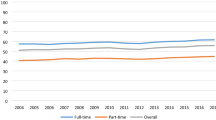Abstract
This study tested a structural equation model of enrollment patterns of white and Hispanic males and females in two-year institutions and the invariance of parameter estimates among the different subgroups in the study. The model represented a multiequation model with three latent endogenous variables, high school academic preparation in mathematics and science, mathematics and science attitudes, and the dependent variable, enrollment patterns in mathematics and science courses. Exogenous variables included parents' education, levels of encouragement by others, and high school grades. Structural equation modeling was used to examine the structural and measurement coefficients of the hypothesized causal model for all subgroups in the study. In summary, an examination of the direct and total effect coefficients revealed different underlying patterns of factors for white and Hispanic females. No convergence on the model was found for white and Hispanic males. Equality constraints on all structural coefficients for both white and Hispanic females were tested and results indicated that all parameter estimates in the structural models for both subgroups were significantly different from each other.
Similar content being viewed by others
References
Armstrong, J. (1981). Achievement and participation of women in mathematics: Results of two national surveys.Journal for Research in Mathematics Education 12: 356–372.
Benbow, C. P., and Stanley, J. C. (1982). Consequences in high school and college of sex differences in mathematical reasoning ability: A longitudinal perspective.American Educational Research Journal 19: 598–622.
Bentler, P. M. (1980). Multivariate analysis with latent variables: Causal modeling.Annual Review of Psychology 31: 419–456.
Bentler, P. M., and Speckart, G. (1981). Attitudes “cause” behaviors: A structural equation analysis.Journal of Personality and Social Psychology 40(2): 226–238.
Broyles, S. (1984).Fall enrollment in colleges and universities 1982. Washington, DC: National Center for Education Statistics.
Clowes, D. A., Hinkle, D. F., and Smart, J. C. (1986). Enrollment patterns in postsecondary education, 1961–1982.Journal of Higher Education 57(2): 121–133.
Davis, J. D. (1986).The Effect of Mathematics Course Enrollment on Racial/Ethnic Differences in Secondary School Mathematics Achievement. Princeton, NJ: Educational Testing Services.
Ethington, C. A., and Wolfle, L. (1986). A structural model of mathematics achievement for men and women.American Educational Research Journal 23(1): 65–75.
Fennema, E. J., and Sherman, J. A. (1977). Sex-related differences in mathematics achievement, spatial visualization and affective factors.American Educational Research Journal 14: 51–71.
Joreskog, K. G., and Sorbom, D. (1984).LISREL: Analysis of Linear Structural Relationships by the Method of Maximum Likelihood (Version VI). Chicago: National Educational Resources.
Kazarian, R. (1984).Women and Minorities Continue Gains in Science, Engineering Employment. National Science Foundation News. Washington, DC: National Science Foundation.
Long, J. (1983).Confirmatory Factor Analysis: A Preface to LISREL. Beverly Hills, CA: Sage Publications.
Malcom, S. M. (1983).An Assessment of Programs That Facilitate Increased Access and Achievement of Females and Minorities in K-12 Mathematics and Science Education. Washington, DC: Office of Opportunities in Science, American Association for the Advancement of Science.
Mestre, J. P. (1986). The Latino science and engineering student: Recent research findings. In Michael A. Olivas (ed.),Latino College Students pp. 157–192. New York: Teachers' College Press.
National Assessment of Education Progress (1983).The Third National Mathematics Assessment: Results, Trends, and Issues. Denver, CO: Education Commission of the States.
National Center for Education Statistics (1985).The Condition of Education. Washington, DC: National Center for Education Statistics, U.S. Department of Education.
Nora, A., and Rendon, L. (1990a). Determinants of predisposition to transfer among community college students: A structural model.Research in Higher Education 31(3): 235–255.
Nora, A., and Rendon, L. (1990b). Differences in mathematics and science preparation and participation among community college minority and nonminority students.Community College Review 18(2): 29–40.
Pallas, A. M., and Alexander, K. L. (1983). Sex differences in quantitative SAT performance: New evidence on the differential coursework hypothesis.American Educational Research Journal 20: 165–182.
Pedhazur, E. (1982).Multiple Regression in Behavioral Research: Explanation and Prediction 2nd ed. New York: Holt, Rinehart & Winston.
Pedro, J. D., Wolleat, P., Fennema, C., and Becker, A. D. (1981). Election of high school mathematics by females and males: Attributions and attitudes.American Educational Research Journal 18(2): 207–218.
Rendon, L. I. (1983).Mathematics Education for Hispanic Students in the Border College Consortium. Laredo, TX: Border College Consortium, ERIC Document Reproduction Number ED 2442 451.
Rendon, L. I. (1985).Mexican American Underrepresentation in Math- and Science-Based Fields of Study: A Guide to Develop Intervention Models. Las Cruces: ERIC Clearinghouse for Rural Education and Small Schools.
Riley, M. (1984). The community college general academic assessment: Los Angeles district, 1983. Unpublished report. Los Angeles, CA: Center for the Study of Community Colleges.
Rock, D. A. (1985).Factors Associated with Decline of Test Scores. A Study of Excellence in High School Education: Education Policies, School Quality, and Student Outcomes. Washington, DC: National Center for Education Statistics, U.S. Department of Education.
Sherman, J. (1981). “Girls” and “boys” enrollments in theoretical math courses: A longitudinal study.Psychology of Women Quarterly 5: 681–689.
Vetter, B. M. (April 1986). Women and minorities in math-based careers: The educational pipeline. Paper presented at the Conference of Chief State School Officers, Columbus, OH.
West, J. (1985).An Analysis of Course-taking Patterns in Secondary Schools as Related to Student Characteristics. Washington, DC: National Center for Education Statistics, U.S. Department of Education.
Author information
Authors and Affiliations
Rights and permissions
About this article
Cite this article
Nora, A., Horvath, F. Structural pattern differences in course enrollment rates among community college students. Res High Educ 31, 539–554 (1990). https://doi.org/10.1007/BF00992620
Received:
Issue Date:
DOI: https://doi.org/10.1007/BF00992620




